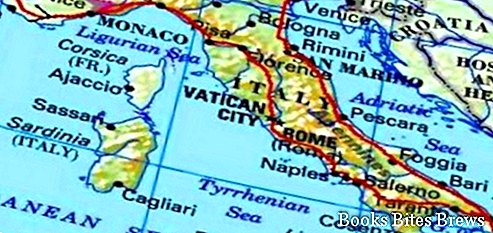Introduction to the geography of Italy in summary form, with information regarding the characteristics of the country's territory, climate and hydrography.
Geographical Italy
For a foreign tourist, a trip to Italy remains one of those rare experiences in life not to be missed, thanks to the cities rich in art and history, excellent cuisine, sweet life and fashion in clothing are just some of the aspects that encourage you to go to the beautiful country.
Archipelagos of islands off the thousands of kilometers of coasts, lakes, volcanoes, verdant hills characterized by olive trees and vineyards, a myriad of sites recognized as a World Heritage Site by UNESCO make Italy a very varied, unique and tourist half the best in the world.
During the Cenozoic period, the Alps and the Apennines rose.
In the Neozoic volcanic eruptions, the modeling exercised by the glaciers and subsequently that of the run-off waters completed the physiognomy of the country with the alluvial deposits that formed the plains.
The Alpine arc includes the major mountain ranges to the west, with constantly snow-capped peaks.
Italy's climate is temperate, with significant differences between the various regions.
In the Alpine region, the temperature decreases with increasing altitude, the annual and daily temperature ranges are large.
Rainy phenomena occur mainly in summer, with increasing intensity from west to east.
As regards vegetation, oak and chestnut woods predominate up to 100 meters, while going up to 1500 m beech woods.
Between 1600 and 2200 m there are coniferous forests with meadows and pastures, over 2200 you enter the shrubland characterized by natural pastures typical of high mountains.
Recommended readings- Artimino (Tuscany): what to see
- Giulianova (Abruzzo): what to see
- Alessandria (Piedmont): what to see in 1 day
- Corigliano Calabro (Calabria): what to see in the medieval village
- San Galgano (Tuscany): what to see
The Po-Veneto region is characterized by a transitional continental climate with average winter temperatures around 0 ° C. and summer averages above 25 ° C.
Precipitation in this intensely cultivated region is not abundant, the oak and oak woods are rare and alternate with dense patches of heather and gorse.
The Apennine region manifests a character of increasing continentality proceeding towards the inland areas with low winter temperatures of just over 0 ° C. and summer temperatures that go up to a maximum of 25 ° C.
The Ligurian-Tyrrhenian region includes the northern and western Tyrrhenian coast and the climate is deeply affected by the mitigating influence of the sea which limits the annual temperature excursions.
The Adriatic region is exposed to Nordic winds with little influence of the low seas on the climate which is almost continental.
The rivers that originate in the Alps and in the Apennines have a fairly regular flow with minimums in winter and maximums in autumn and summer.
The rivers that are part of peninsular Italy are mainly fed by rains and have torrential character.
The rivers in the islands, on the other hand, have a more pronounced torrential character with abundant winter floods and scarcity of water in the summer.
The majority of Italian rivers flow into the Adriatic Sea, the largest of which is the Po.
The Arno, the Tiber, the Serchio and other minors flow into the Tyrrhenian Sea.




